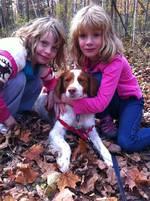
Did you know during the months of March through May, there is an International Dog Bite Prevention Challenge? Here at Mitchell Veterinary Services, we believe that dogs can greatly enhance the life of children and therefore, we are staunch promoters of safe interactions between dogs and children. The following is information to prevent dog bites from happening.
Why do dogs bite?
There are many reasons why dogs can bite children including (but not limited to) the following:
- Fear/anxiety.
- Pain (injury, arthritis, illness, etc). This can also apply to a child pulling a dog’s hair/tail/ears.
- Protecting a resource (food, toys, resting spot, puppies, etc).
- Protecting his owner or property.
- The child invaded the dog’s space and made him uncomfortable (hugging, laying on him, stepping over him, staring directly into his eyes, etc).
- The dog has a high prey drive or is a herding breed who has an instinct to chase running animals and nip to herd them.
- The dog has reached the end of his tolerance with the situation.
When and why do dogs bite without warning?
Dogs ALWAYS show warning signs that they may bite. Dogs never bite “out of the blue”. Biting is always a result of too much stress placed on the dog in that situation. Unfortunately, most people cannot recognize these subtle signs and place children and dogs into positions where biting occurs.
What are the warning signs?
- The dog is actively avoiding/walking/leaning away from the child.
- Yawning.
- Holding its tail low or up very high, even if wagging.
- Licking its lips.
- The dog is giving a pleading look or you can see the whites of his eyes in a half moon shape.
Note the warning signs this dog is showing: leaning away, half-moon eyes, pleading look to owners to stop the situation. Without intervention, this dog may bite the baby since the dog is clearly uncomfortable.
How do we prevent dog bites from happening?
- Always supervise children’s interactions with dogs. With infants, a hand should be kept on the dog at all times. Toddlers should always be kept within arm’s reach when interacting with dogs. With children, an adult should be in the same room as them when there is a dog around.
- Watch your dog’s body language. If your dog is showing any of the signs listed above, stop the interaction immediately.
- Have a safe spot for your dog where it can go if it wants to get away from the children, such as a crate or separate room.
- Ask your veterinarian or other animal professionals what breed of dog may be most appropriate for your family and lifestyle.
- Teach your children the following important rules for being around dogs:
– Be gentle with dogs and do not pull their tail, ears or fur.
– Do not run or scream when around dogs. Never run when a dog approaches but stay calm and quiet.
– Never hug or step over a dog. Respect a dog’s personal space. Never stare into its eyes.
– Never sneak up on or surprise a dog.
– Never approach or pet an unknown dog. If a dog walks away from you, leave it alone.
– Do not approach a dog that is eating, chewing on a bone or toy, sleeping, or has puppies.
– Pet a dog under his chin or on his back. Do not reach over his head.
– Always ask the owner before petting a dog.
Any and all dogs, no matter the age, sex, breed or experience with children, have the potential to bite. The majority of children who are bitten are bitten by a dog they know. Unfortunately, in these cases, most of the bites occur around the face and neck since those are often the closest parts of the body to the dog. This can cause lifelong scarring and emotional trauma to the child.
The best ways to prevent dog bites from happening are to teach children how to act around dogs and to always watch for signs your dog is stressed. Even the most tolerant of dogs can reach the end of its rope and bite as a way to stop a child from performing the unwanted behaviour. In the cases we hear of most, the bite was “out of nowhere”; when in fact, there were likely many signs the dog was showing before it bit. Adults should also know the signs and intervene. Dogs should not be expected to “tolerate” behaviours that are very stressful for them.
For more information on how to keep children safe around all dogs, visit the Doggone Safe Website: http://www.doggonesafe.com/
Also read our blog on: Considering Your Pet When Welcoming a New Baby

